
The Bakerloo line is a London Underground line that runs from Harrow & Wealdstone in suburban north-west London to Elephant & Castle in south London, via the West End. Printed in brown on the Tube map, it serves 25 stations, 15 of which are underground, over 23.2 kilometres (14.4 mi). It runs partly on the surface and partly through deep-level tube tunnels.
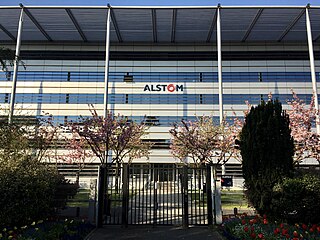
Alstom SA is a French multinational rolling stock manufacturer which operates worldwide in rail transport markets. It is active in the fields of passenger transportation, signaling, and locomotives, producing high-speed, suburban, regional and urban trains along with trams.

Metro-Cammell, formally the Metropolitan Cammell Carriage and Wagon Company (MCCW), was an English manufacturer of railway carriages, locomotives and railway wagons, based in Saltley, and subsequently Washwood Heath, in Birmingham. The company was purchased by GEC Alsthom in May 1989; the Washwood Heath factory closed in 2005 and was demolished in early 2019.
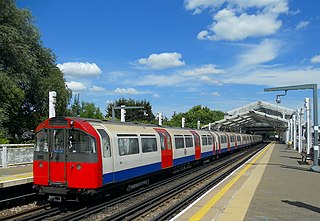
The London Underground 1973 Stock is a type of rolling stock used on the Piccadilly line of the London Underground. It was introduced into service in 1975 with the extension of the line to Hatton Cross, followed by a further extension to Heathrow Central in 1977. A total of 86 six-car trains were built.

The 1959 Tube Stock was a type of London Underground tube train constructed in the late 1950s. They were intended for use on the Piccadilly line, but also saw use on several other tube lines. It was the first production tube stock to have unpainted aluminium alloy bodywork.
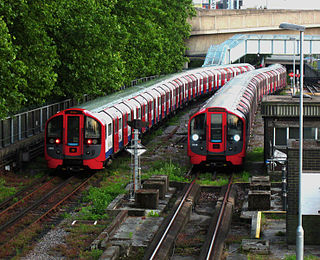
London Underground rolling stock includes the electric multiple-unit trains used on the London Underground. These come in two sizes, smaller deep-level tube trains and larger sub-surface trains of a similar size to those on British main lines, both running on standard gauge tracks. New trains are designed for the maximum number of standing passengers and for speed of access to the cars.

The London Underground 1992 Stock is a type of rolling stock used on the Central and Waterloo & City lines of the London Underground. A total of 85 eight-car trains were built for the Central line and 5 four-car trains were built for the Waterloo & City line.

The Standard Stock title was applied to a variety of Tube stock built between 1923 and 1934, all of which shared the same basic characteristics, but with some detailed differences. This design is sometimes referred to as 1923 Tube Stock, 1923 Stock, or Pre 1938 Stock. Most of the Standard Stock was built to replace the first generation of "Gate Stock" Tube trains or to provide additional trains for extensions built in the 1920s and early 1930s. Standard Stock cars consisted of motor cars, with a driver's cab, behind which was a "switch compartment" occupying approximately one-third of the length of the car, plus trailer cars and "control trailers", with a driving cab but no motor. All were equipped with air operated sliding doors. The guard's door on the earlier trains was a manually operated, inward-opening hinged door.

The London Underground A60 and A62 Stock, commonly referred to as A Stock, was a type of sub-surface rolling stock which operated on the Metropolitan line of the London Underground from 12 June 1961 to 26 September 2012, and on the East London line from 1977 until 22 December 2007, when it closed to be converted into London Overground.
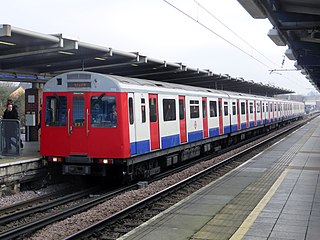
The London Underground D78 Stock, commonly referred to as D Stock, was a type of sub-surface rolling stock which operated on the District line of the London Underground, except on the Wimbledon to Edgware Road service. The first units were withdrawn in January 2015 with the last withdrawn on 21 April 2017.

The London Underground 1983 Stock was a class of electric multiple unit built by Metro-Cammell for use on London Underground's Jubilee line.

The London Underground 1972 Stock is a type of rolling stock used on the London Underground. The 1972 Stock was originally ordered to make up the shortfall in trains on the Northern line's 1959 Tube Stock fleet, but is currently used on the Bakerloo line. Following the withdrawal of the British Rail Class 483 EMUs in 2021, the 1972 Stock are now the oldest EMUs in passenger service in the United Kingdom. A total of 63 seven-car trains were built in two separate batches.
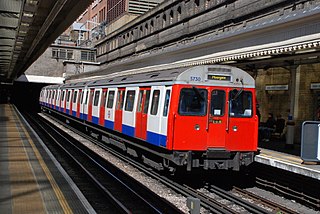
The London Underground C69 and C77 Stock, commonly referred to as the C Stock, was a type of sub-surface rolling stock used on the Circle, District and Hammersmith & City lines of the London Underground between 1970 and 2014. They were replaced by the S7 Stock.

The London Underground 1967 Stock was a type of deep-level train that operated on the Victoria line of the London Underground from the line's opening on 1 September 1968 until 30 June 2011. It was also used on the Central line between Woodford and Hainault between 21 February 1968 and 1984, as the same automatic train operation (ATO) system was used on both lines.

London Underground battery-electric locomotives are battery locomotives used for hauling engineers' trains on the London Underground network where they can operate when the electric traction current is switched off. The first two locomotives were built in 1905 for the construction of the Great Northern, Piccadilly and Brompton Railway, and their success prompted the District Railway to buy two more in 1909, which were the only ones built to the loading gauge of the subsurface lines. Following this, a number of battery vehicles were built by converting redundant motor cars, with the batteries placed in the unused passenger compartment. One exception to this was made by the City and South London Railway, who used a trailer car to hold the batteries, and wired them to a separate locomotive.

The London Underground 1996 Stock is a type of rolling stock used on the Jubilee line of the London Underground. The trains were built by GEC Alsthom-Metro-Cammell and entered service in 1997. They are externally similar to the 1995 Stock used on the Northern line.

The Metro Cammell EMU is the oldest variation of electric multiple unit that operates on the MTR rapid transit railway system in Hong Kong. A total of 768 cars were built by Metro-Cammell in England between 1977 and 1994, and refurbished from 1998 to 2001 by United Goninan.

Ruislip depot is a London Underground traction maintenance depot on the Central line, and is situated between the stations of Ruislip Gardens and West Ruislip in the London Borough of Hillingdon. The depot is accessible from both ends, and was built for the Central Line extensions under the 1935-1940 New Works Programme. It was nearly completed by 1939, when the outbreak of the Second World War prevented further work. It was used as a factory for anti-aircraft guns during the war, and was finally opened in 1948. The main car shed has 16 tracks, and there is also a three-track car cleaning shed.

Acton Works is a London Underground maintenance facility in West London, England. It is accessed from the District line and Piccadilly line tracks to the east of Acton Town station, and was opened in 1922. It was responsible for the overhaul of rolling stock, and gradually took on this role for more lines, until the formation of the London Passenger Transport Board in 1933, when all major overhauls of underground vehicles were carried out at the works. By 1985, when rolling stock had become more reliable and maintenance intervals had increased, this function was devolved to depots on each line. Subsequently, Acton continued to overhaul major items after they had been removed from trains at the depots, and tendered for work, which included the conversion of the A60 Stock to One Person Operation. It is likely to be reorganised and expanded to house the departments displaced from Lillie Bridge Depot which is being demolished as part of the redevelopment of Earls Court Exhibition Centre.

Morden Depot is a British rolling stock depot on the London Underground Northern line, and is located to the south of Morden Underground station. It was opened in 1926, when the City and South London Railway (C&SLR) was extended from Clapham Common to Morden.























